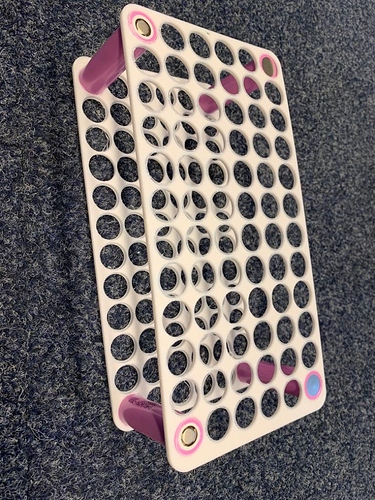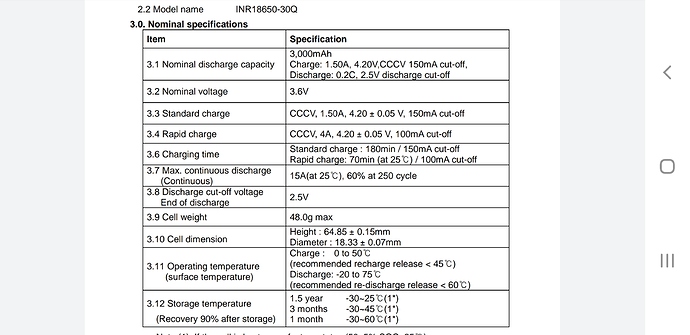Sucks when you build I and I doesn’t fit. Hopefully you can find a solution. Are you planning on a BMS?
I’m on the process of building 2 VTC6 packs, had the cells from Nkon but I still waiting to receive the stupid Lipo to power up my Arduino spot welder…
I’m facing the same drama: 2x 6s 14p can barely fit my housing if gluing the cells alternated with no plastic spacers, I when hot gluing rows of14 cell I kept a minimum clearance cell to cell, the glue help. The problem is that I can’t fit the spacers.
30A rated cell in 14p setup gives me some peace of mind, I always fuse my efoil with 90-100A max, right after the batteries, Tesla system looks good but I don’t want to touch cells with a solder iron. I do solder and I’m not so convinced that you could do an hot solder in less than 3 seconds on a 18650, and if so, it wants a very hot iron and lots of solder…
You can spot weld fuse wire. But it is difficult to do until you master the technique. I have no experience with spot-welding.
Which size/type/gauge of wire do you suggest for 10-15A? VTC6 are rated up to 30A, so at least 10A fuse is necessary (140A max current at 14s)
Search for spot weld fuse wire on YouTube. A number of videos showing how to do it.
PLEASE USE SAFTY GALSSES WHILE WELDING! I recommend to have a bag of sand, li-ion cells doesn’t require oxygen to ignite or create enough heat to ignite sounding material
I had a couple of short cut with 18650 , the cell will heat up very fast and de-gas through the top ( between the + and the - ring ) always add time to take it away , no fire so far …
With time fuse will become weaker and weaker , 20awg is used on eSkate …
Read the manufacter spec , short cut cell discharge around 150-200A
Here is the 30q safety test
Not found the vtc6
But the 30q gives 138A , so I guess fuse should blow before but not too fin to keep good contact, 30awg looks to weak to me
I do not understand why you want to use the fuse on every cell. This is a bottle neck for your current. I do not know about Sony, but I assume they have same safety standard as Samsung. Even a shortcut of the cell will not resume in any fire or explosion. The cell will heat up to something between 60 and 100C and then it is dead.
Where can be found an alternate pattern cell holder to 3d print? I remember to have seen photo of it on this forum, am I wrong? …just to avoid having to cad such a boring thing!
That’s why I did the test. No voltage drop at 15amps with 1/2" 30awg. Fuse wire doesn’t start getting warm till over 15 amps. It’s funny how everyone just wants to do what they see everyone else doing. That’s why I created this thread. I want to document the process of building a pack using individual cell fusing. Stay tuned to see outcome.
The Samsung 30Q cells get up to 137°F (58°C) during a continuous 10amp discharge (See test above).
During a short circuit they get to over 300°F (150°C). In a pack with hundreds of cells, the combined thermal runaway, even if the cells themselves don’t catch fire they will get hot enough to spontaneously combust fiberglass, plastic, foam, and things like that.
By fusing the individual cells at a value below the current required to cause thermal runaway will result in that individual cell fuse melting. The pack will continue to operate normally at it’s rated voltage and you will notice the failure during charging because that cell group will require more balance charge protection.
There is a reason Tesla builds their batteries this way.
Will it work for e-foil? Stay tuned!
Not sure what you are looking for. Something like this?
Thank you! Yes, something like those but that can hold each row let’s say at 45deg than the other, like when you glue the cells, I need to reduce the width as much as possible.
On Aliexpress, you have different types of oblique battery holders
https://www.aliexpress.com/item/32967174904.html
along with varying sizes of oblique or “W” pure nickel strips
Here 23.5 x 18.3mm (no plastic bracket), they exist in larger pitch to take into account the bracket dimensions
https://www.aliexpress.com/item/32966878183.html
Does soldering 18650 cells damage them?
I have done some testing with a thermal camera and come to the conclusion that the maximum temperature the cell is exposed to during soldering (with the correct technique) is within the batteries rated operating temperature.
See attached picture and video. Maximum rated discharge temperature for Samsung 30Q cell is 167°F (75°C). And the peak temperature during soldering is only for a few seconds.
Soldering cells does not expose the cell the temperature above this value.
Tested fuse wire.
1/2" length of 30awg on both battery terminals.
Fuse wire does not exceed the temperature of the battery cell at 10amp discharge rate.
The fuse wire voltage drop remains below 3%.



